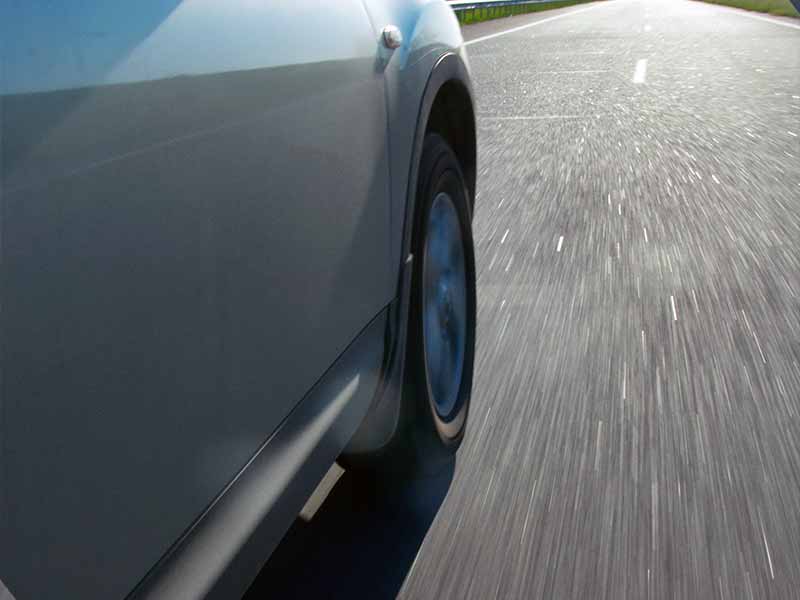Unusual tire noise at low speeds is usually a sign of a problem. Sometimes it’s a minor issue that’s easily corrected. Other times is something much more serious, or not even a tire but a suspension component such as a bad wheel bearing.
Any strange noise should be diagnosed to ensure your vehicle is safe.
Tire Noise At Low Speed
Common causes of unusual tire noise at low speeds are uneven wear, tire punctures, over or underinflated tires, tire scuffing due to improperly aligned tires, or separated or broken steel belts within the tire itself.
Tire noise can be caused by a large number of problems and even be confused with sounds not actually related to the tires themselves.
Let’s take a closer look.
Uneven Tire Wear
If you notice a humming tire noise or road noise as you drive around, it could be due to abnormal tire wear. For reference, this is when one or more of your tires has uneven tire wear patterns when compared to normal tire wear.
When you have uneven tire wear, the excessive noise you hear is the result of the inconsistent shape of the tread blocks unevenly coming in contact with the road.
There are a few causes of uneven tire wear that you should be conscious of.

Not Regularly Rotating Your Tires
Tire rotation is an important part of tire maintenance that will help you to avoid uneven wear. A rotation is when you swap the position of your wheels around the car.
By rotating the position of each of your tires you will reduce the chance of uneven wear. This will help quiet tire noise and will also extend the life of all four tires.
We recommend having a tire rotation performed every 5,000 miles since this will meet or exceed the tire warranty requirements of most tire manufacturers mileage warranties.
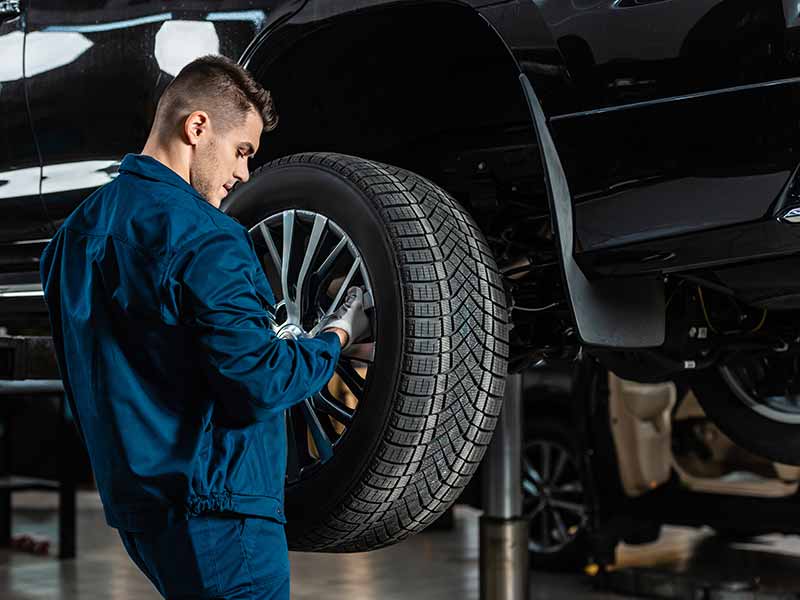
Poor Alignment
Wheel alignment refers to how straight your tires are in relation to each other, your vehicle, and the road surface. Perfectly aligned tires will last the longest, make the least tire noise, and optimize your car’s performance.
When your tires are misaligned a lot of problems occur, such as a squealing noise at low speeds. One of the more obvious symptoms is uneven tire wear, due to the physics at play while you’re driving.
Also, improperly aligned tires can cause tires to drag in slightly different directions from the direction of travel and create low speed tire noise not just from the uneven tread wear but also the angle they come into contact with the road surface.
Be sure to get a wheel alignment every 10,000 miles — to help ensure your tires wear evenly, stay quiet, and last as long as possible.
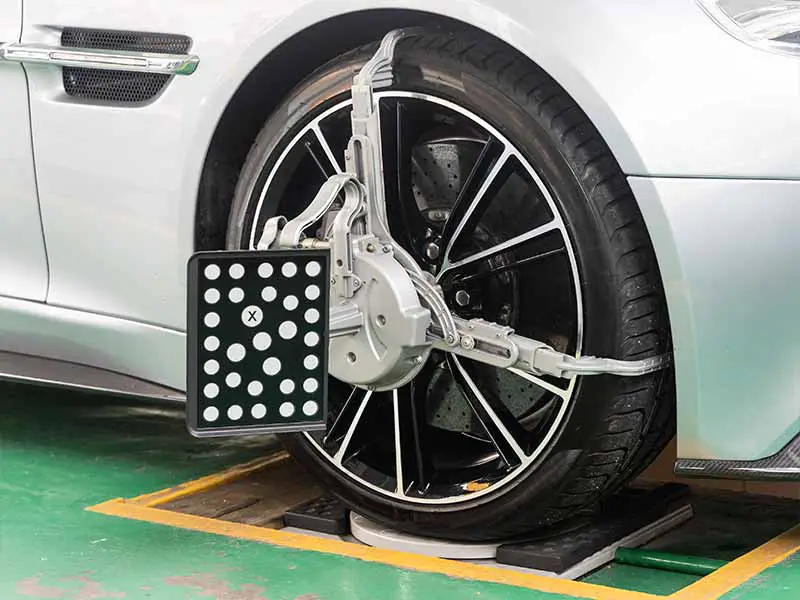
Improper Inflation Pressure
Your tires’ inflation pressure plays a role in how much of the tread pattern comes into contact with the road.
Perfectly inflated tires should come in contact with the road evenly. If the tires are overinflated, the center of the tread will bulge out. Under inflated tires will have the opposite effect, and you’ll be driving mostly on the outer edges of your tread.
In either case, you’ll notice uneven wear in either the center or outer edges of your tread.
You should check the tire pressure of all four tires monthly. You can find the vehicle manufacturer’s recommended air pressures on the driver door frame or door jamb.
I recommend purchasing a good quality portable air compressor to avoid needing to use the unreliable air compressors at gas stations and make it much easier to make sure your tires are properly inflated.

Out Of Balance Tire
Balancing your tire entails adding weights to ensure the tire is perfectly balanced at the center-most point. By design, the axle of your vehicle will go through the center-most point of your wheels.
If they’re not balanced, then you’ll notice vibrations as you drive since the tire has a more oblong path (instead of a perfectly circular path) as it spins. This might cause different parts of your tire to wear prematurely.
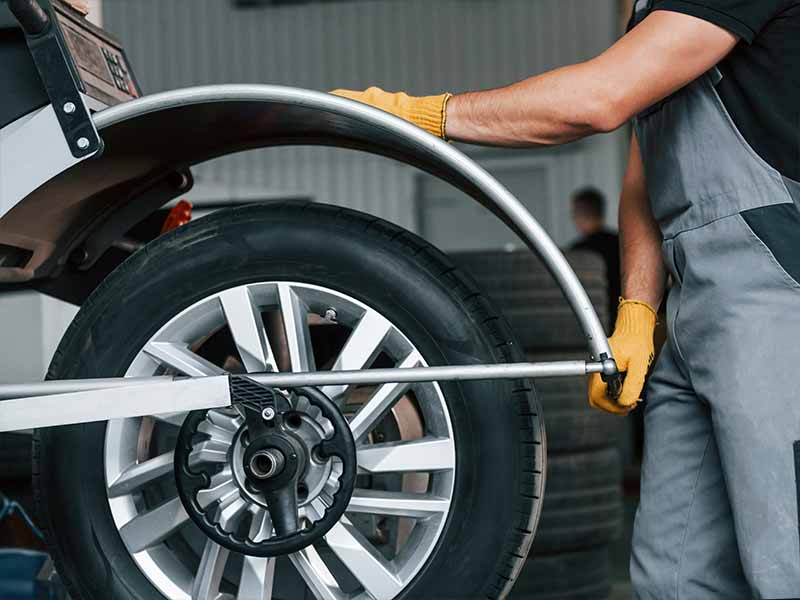
Womp Womp Tire Noise
If you hear a repetitive womping tire noise as you drive, you could have a serious problem. Try to pull over as soon as possible and start troubleshooting.
Tire Damage
Tire damage in one part can cause a rhythmic tire noise as your tires rotate and hit the damaged area. This damage can be due to a number of different reasons.
Foreign Object Damage
“Foreign object damage” is a catchall phrase that describes any object or road debris that gets stuck in your tire. Some of the most common culprits are bolts, screws, and nails that you run over while driving.
Some of these objects may not be as noticeable when driving at higher speeds, but the tire noise at low speed is more obvious.
Punctured tires shouldn’t be driven on if you can help it, but you also shouldn’t remove the object that has punctured your tire if the tire is still holding air enough to allow you to cautiously drive to your nearest tire shop.
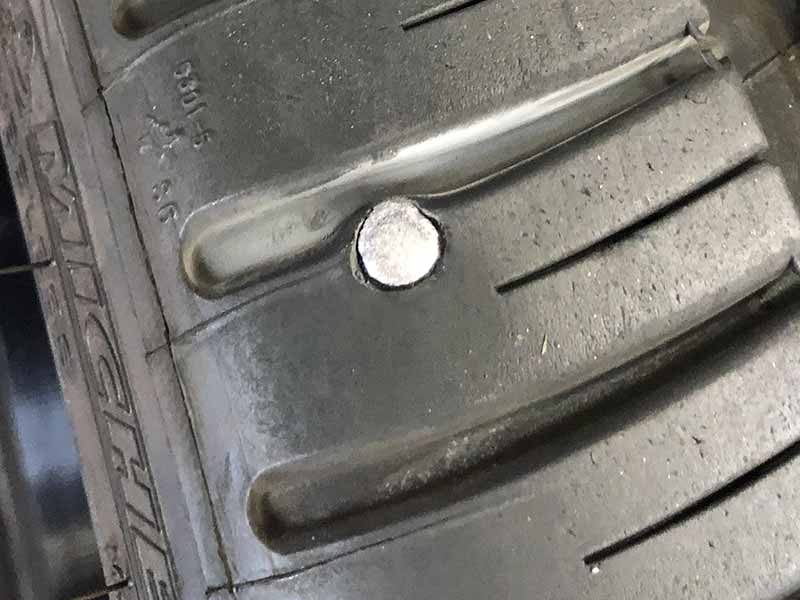
Belt Separation
Within the construction of your tire are several layers of belts or plies. These belts are what give your tire shape and strength. Defective construction or tire damage from potholes or curb strikes can cause the belts to separate within the tire itself.
When one of these belts separates it can allow the tire to come out of round which makes for noisy tires. It may also cause a cupping pattern to form on your tire tread due to the uneven pressure as the tire is rolling forward.
Separated or shifted belts can be very dangerous. You should avoid driving on tires with this type of damage and have them replaced as soon as possible.
Sidewall Bubble
A bubble or bulge on the sidewall of your tire is another dangerous form of tire damage. It typically means that you have structural damage, such as a broken belt, inside of your tire. Sidewall bubbles are extremely dangerous and can lead to a catastrophic blowout.
Like belt separation, bulges can cause tire noise at low speeds due to the tire no longer being perfectly round.
It’s usually easy to spot the bubble or bulge. Once you do, it’s best to avoid driving until you can get the tire replaced.
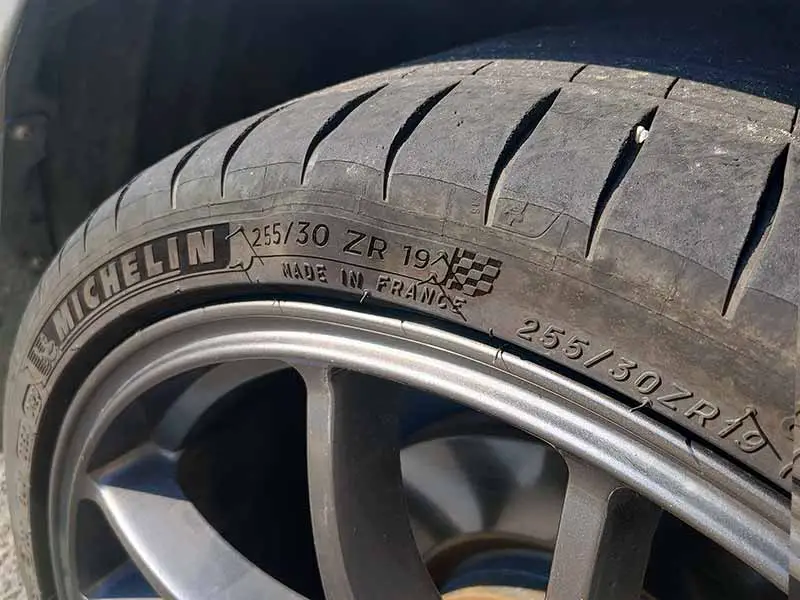
Wheel Damage
Bent wheels are often the result of potholes and curb strikes. It’s not uncommon for cars and trucks low profile tires to have more trouble with bent rims since they have much less sidewall to absorb the impacts of everyday road abuse.
Minor wheel damage can sometimes be corrected with a few extra wheel weights when balancing, or fixed by bending the wheel back into proper shape. Other times the damage is too severe and you’ll need to replace the wheel, which is often quite expensive if you have premium alloy wheels.
Tire noise at low speed from wheel damage is usually caused by the wheel no longer being perfectly round. The noise may not be very noticeable at both low and high speeds.
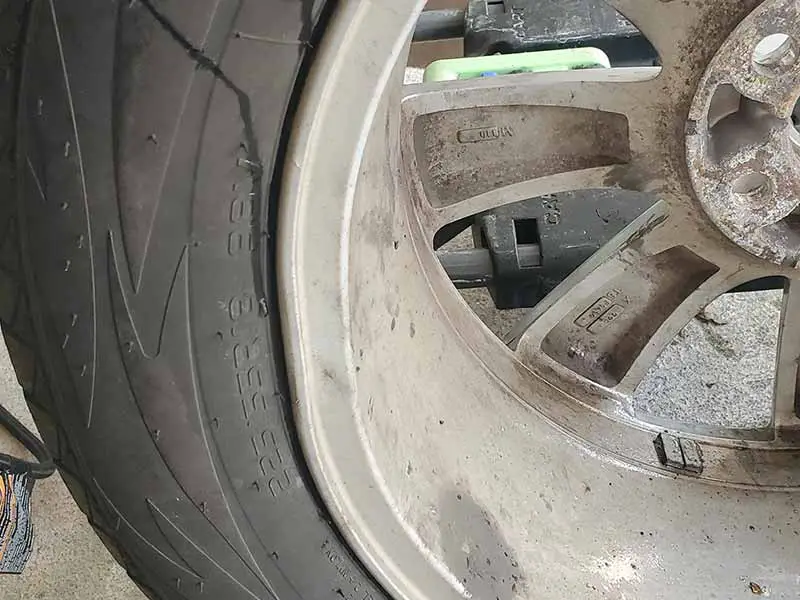
Non-Tire Or Wheel Causes
When you hear a tire noise at low speed, it might be something other than the tire. In this section, we’ll cover non-tire causes that might make noises so you’ll know how to fix tire noise.
Wheel Bearings
The wheel bearing makes sure your wheel can spin smoothly with very little friction and noise. Like most mechanical components, wheel bearings eventually begin to fail. They usually do so by beginning to make a humming or squealing noise or sometimes more of a howling noise.
A wheel bearing failure is an extremely serious problem and should be fixed immediately. Wheel bearings don’t stop at just making a bit of noise.
Bad wheel bearings will continue to degrade, usually rapidly. Complete wheel bearing failure could allow the wheel to separate from the suspension, which as you can imagine would be a serious problem when driving at high speeds. Or it may seize and cause the wheel to suddenly stop spinning while you’re driving.
If you suspect you have a bad wheel bearing after noticing a humming noise or squealing sound, you should have it checked out by your mechanic as soon as possible and avoid driving unless absolutely necessary.
A bad wheel bearing isn’t a problem that will usually happen with newer cars and trucks. But once your vehicle gets a bit of age and a hundred thousand miles on the odometer, it’s a problem to keep in the back of your mind to be aware of happening.
CV Joints
CV joints, which is an abbreviation for constant velocity joint, is a suspension component that is designed to allow suspension parts to move up and down or forward and back while still connected to the drive shaft.
Anytime a driven axle is connected to a wheel assembly a CV joint is required. It’s a common part that needs occasional servicing to prevent failure. Usually re-greasing and replacement of the CV boot that holds the grease around the joint.
A common sign of a CV joint beginning to fail is a popping noise or clicking sound while turning at low speeds.
Shocks/Struts
Cars and trucks ride on springs to soften the ride, but shocks and struts are needed to prevent you from bouncing down the road after every bump. They work by dampening the rebound of the spring.
As shocks age or fail they lose their ability to properly dampen the rebound of the spring and the wheel will begin to bounce more after every bump.
Since your tires will not have consistent pressure on the pavement unusual wear patterns can form on your tire tread and cause tire noises as you drive at low speeds such as tire hum.
Lug Nuts
Vehicles use lug nuts to secure wheel assemblies to the suspension system. If not torqued down to the proper specification they can cause certain problems.
Overtightened lug nuts can actually cause brake rotors to warp slightly which can cause the brake pads to contact the brake rotor and make a grinding noise that is most noticeable at low speeds.
Obviously wheels with lug nuts that weren’t tightened well could cause wheel wobble and be quite dangerous. Even allowing the nuts to back out and the wheel to come loose from the vehicle.
Hub Caps
Hub caps are decorative covers that are usually designed to cover less expensive steel wheels. They aren’t necessary parts of your vehicle but they can make a huge difference visually.
On rare occasion, hub caps can be responsible for what you might mistake for tire noise sounds. Improperly mounted hubcaps make cause noise from airflow over them or rattle slightly, which is much more noticeable at low speeds.
Accessory Belts
Accessory belts are found under the hood to power things like your alternator, air conditioning, water pump, and power steering pump.
It can be difficult to tell precisely where noise is coming from and a worn accessory belt can make the same noise as a tire squealing. Squealing noise is often associated with tire noise so it’s common for these sounds to get confused with each other.
Resources
Below are some links you may find helpful when learning about tires
Final Thoughts
Good tire maintenance is not only important to reduce tire noise, but to also help you get the most out of your tires and keep you safe.
Diagnosing noisy tires can be difficult but simply purchasing a set of new tires won’t necessarily make the problem go away. It’s important to solve the problem that is causing the noise so that it won’t shorten the life of your replacement tires.
Good luck and happy motoring.
